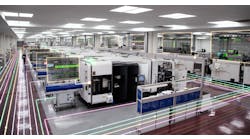No-Code Robot Interfacing
Platform for Smart Factory Automation
Swiss Productions in Ventura, Calif., has over 50 screw machines and 30 secondary machines in operation, supporting its output of precision components parts ranging from 2.5 in. diameter down to 0.19 in. diameter -- syringe tips, in fact. Such products, and such a range of parts produced, means there is a steady challenge to meet the demands of customers while maintaining consistent product quality and preserving a creative, forward-thinking approach to problem solving.
Specifically, the shop recognized that with all the variety of its output it was not maximizing spindle time. Keeping one Haas milling machine running consistently was a particular goal.
“The machine would only get 9 hours of production a day, and an employee would sit on the machine loading and unloading every 7-8 minutes, and take one hour worth of breaks a day,” explained general manager Timo Lunceford. Of course, production could also be interrupted if the machine operator lost focus while attending to other tasks.
Swiss Productions’ goal became “lights out” operation, keeping the machines running 24 hours a day.
“Our operators would stand for 10 minutes, wait for the part to finish and then reload it,” Lunceford added. “We were losing precious time that could be used more efficiently.”
This is the situation that led Swiss to investigate various new options for collaborative robots, leading the shop to Productive Robotics and its OB7 cobot. The OB7’s seven axes of operation were expected to add the extra flexibility for handling that the shop’s CNC machines required.
The OB7 is a collaborative robot specifically for automating CNC machine tending and supplied fully equipped to connect to any brand of CNC machine. The unit is delivered ready to install, ready to begin automated machining. No programming is needed to teach the OB7, so machine operators can set-up jobs quickly.
“When we discovered OB7, we knew the seventh axis for us is key. We are going in, grabbing the parts, moving sideways with them, and then blowing out the collets that we are using to hold our parts. We need a quick turn radius because we also have to teach it to close the door and then double-check that the door is closed -- and then to be able to pivot to press the start button, which is a complete 180° from where it was,” Lunceford detailed.
Integrating OB7 with the Haas milling machine was accomplished entirely by Swiss employees, no outsourcing needed. In a few days, OB7 was up and running.
Very quickly Swiss Productions was working lights-out, Swiss gaining an extra 32 hours per week of machine running time atop of the normal 40 hours. In addition, the ship gained back the hours lost during breaks, bringing the total weekly production time up to 76 hours.
Employee productivity had been another objective for Swiss Productions, and with OB7 tending the machines the machinists are available to take on other tasks that advance production. “The employee that would normally sit at the machine before OB7 is now able to run two of our smaller lathes at the same time. Previously, the cycle times wouldn’t allow for that between all three machines,” Lunceford recalled.
The increase in productivity – now up to 2 million parts per month -- thanks to the cobot was easy to recognize, and Swiss Productions decided to implement a second OB7 for another milling machine.
“We have not let go of any employees and our production has increased,” Lunceford noted. “We have big plans for OB7, and not just on our mills but on our lathes, too, where we are producing parts as well.”








